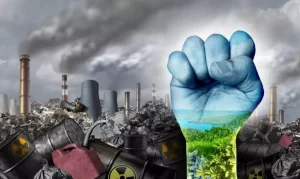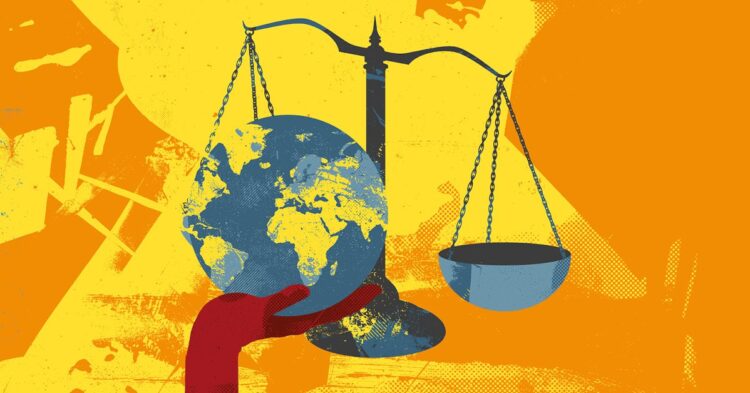
Kalaiyarasan V.
Madras Institute of Development
Studies and Visiting Research Fellow, King’s College, London

Santhosh
Kumar Sahu
Indian Institute of Technology,
Madras
The G-20 summit that was held in Delhi (September 9-10) agreed on tripling renewable energy capacity and a voluntary doubling of the rate of energy efficiency improvement by 2030. However, this Delhi Declaration on the climate question did not find consensus on the most contentious issue, which is the root cause of the climate crisis of the phasing out of fossil fuels. Any energy transition initiative must embrace two normative ideals: first, internalising cost requires those who emit greenhouse gases to pay the social and environmental costs. Second, climate justice requires compensation for those who are harmed. Often, those who contribute to climate change are not the ones who are affected by it. Therefore, any mitigation effort must invert this carbon injustice by making the richer countries or richer classes within a country pay for the energy transition.
While these two principles are articulated at the international level, how such policies and politics affect the domestic front do not get debated. India’s stance on the matter has largely been framed through the lens of foreign policy and its approach to common but differentiated responsibilities (CBDR) in international negotiations, which allows developing countries in the global south to prioritise economic growth and development over climate mitigation. Given the country’s historically lower emissions, focusing on economic growth has naturally taken precedence over climate concerns. Such an approach evades concerns of climate justice within India, particularly its effect on inequality across levels class, caste and region.
Inequality matrix
It is now well documented across the world that climate change and energy transition disproportionately affect the poor. The climate-induced problems and droughts have compounded the agrarian crisis and allied economic activities. Variations in rainfall, temperature and extreme climate events directly impact agricultural productivity, compounding farmers’ income loss. Rising temperature in the ocean ecosystem has already begun squeezing fish stocks in parts of the country, hurting fishing communities.
While the relationship between inequality and carbon emissions is complex, it is clear that addressing both environmental and socio-economic inequalities simultaneously is essential for sustainable and equitable development. It is now evident that less equitable | imperatives of a just transition of the workforce societies tend to have higher emission outputs per unit of economic activity. Given its highly unequal economic structure, India is falling in that trap. Global experience suggests that societal responses which are necessary to address climate change (such as public action and state capacity), are impeded in more unequal settings. The cost of carbon emissions, in terms of societal impact, becomes significantly higher in such contexts. Recognising and mitigating the barriers that these inequality matrices pose to effective climate action is a critical step toward a more sustainable and just future.
Greening development
If climate change compounds existing inequalities, India’s energy transition policies, though crucial, will affect the livelihoods of the poor and exacerbate existing class, caste, and regional disparities. India’s Nationally Determined Contributions (NDC) aim to ensure that 40% of the total installed power generation capacity is clean energy. The country has pledged to achieve net-zero emissions by 2070. Such an ambitious target necessitates careful study of its implications. As of 2021, coal was the major contributor to the total energy supply in India (accounting for 56.1%), followed by crude oil (it accounts for 33.4%).
Similarly, the industrial sector was the largest consumer of energy, using more than half, i.e., 51% of the total final energy consumption, followed by transport (11%), residential (10%), and agriculture (3.6%) sectors. Data show that manufacturing is far more energy- and carbon-intensive than agriculture and services. Consequently, any increase in energy price is likely to lead to a contraction of manufacturing, which India cannot afford given its already low manufacturing level. Thus, a just transition entails a holistic approach that considers economic, social, and regional inequalities. While renewable energy adoption is crucial, this shift should not exacerbate existing disparities. For instance, regions that are heavily reliant on coal production face a unique set of challenges. These regions often struggle with pollution, poverty, and low-quality employment.
Transitioning to renewables requires a deliberate focus on protecting livelihoods, offering alternative job opportunities, and ensuring that vulnerable communities are not adversely impacted. The emphasis in the Paris Agreement (2015) is: “taking into account the imperatives of a just transition of the workforce and the creation of decent work and quality jobs per nationally defined development priorities”. The skill sets required and the jobs generated per unit of output in renewable vastly differ from fossil fuel industries. Many fossil fuel firms are in the public sector and act as a critical avenue for creating job opportunities for Dalits and the lower castes in India. A shift to renewable energy can potentially halt this generational mobility achieved by these disadvantaged groups. To ensure an equitable and sustainable transition, strategies must target inequality reduction and green investment simultaneously.

Greening federalism
Similarly, regions heavily reliant on coal production may lose revenues and livelihoods. This regional divide in economic inequality correlates with the energy source divide in India. Coal, the cheapest source of energy, is located in the poorer regions in eastern and central India while renewable energy hubs, powered by wind and solar photovoltaics (PV) technologies, are located in the relatively wealthy southern and western India.
Despite the pollution it causes, the coal sector, owned by the public sector miners (85%), is the main source of revenue via taxes, royalties, and mining fees and employment for the State governments in Odisha, Jharkhand, and Chhattisgarh. India’s energy transition strategy must pay attention to these regional inequalities, transfer funds to States dependent on coal, and carve out State-specific programmes for reskilling development and local rehabilitation needs.
Thus, the Green Deal needs to have a federal deal. India’s federal governance structure implies that sub-national governments play a significant role in addressing climate concerns. However, their priorities can differ significantly from those of the Union government. Examining sub-national responses reveals how State entities are vital in tackling the challenge of climate inequality mitigation. State governments have been found to implement policies, including those related to climate justice, climate adaptation, and disaster management laid out by the Union government, that are often at odds with the development aspirations of the States. We must delve into the intricate interactions between fiscal federalism and climate mitigation to understand how policy alignment and cooperation can be achieved across the levels of government.
Courtesy: The Hindu









